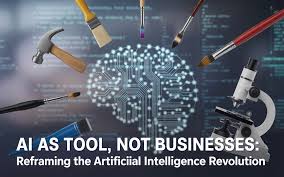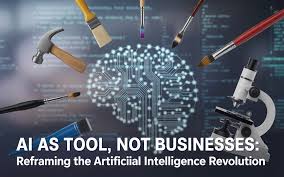https://theworldfinancialforum.com/participate/

In recent years, artificial intelligence has emerged as the defining technology of our time, capturing headlines, investor attention, and public imagination in unprecedented ways. From boardrooms to Silicon Valley garages, AI has often been framed not merely as a technological advancement but as a business category in itself. The narrative of “AI companies” and “AI-driven businesses” dominates tech conferences, venture capital pitches, and market analyses. Yet this framing fundamentally misunderstands AI’s true nature and potential value.
At its essence, AI is not a business model but a powerful tool—one that augments human capabilities, transforms processes, and unlocks new possibilities across virtually every industry. Recognizing AI as a tool rather than a standalone business shapes smarter investment decisions, corporate strategies, and technological progress. It allows organizations to avoid hype-driven pitfalls and focus instead on meaningful applications that deliver real value.
Learning from Technological Revolutions Past
History offers instructive parallels. Every major technological revolution has followed a pattern of initial hype, misunderstanding, and eventual integration. Consider the internet. During the late 1990s dot-com boom, companies believed that simply adding “.com” to their name constituted a business model. Investors poured billions into firms with little more than a website and a vague promise to “leverage the internet.” The subsequent crash wiped out trillions in market value, but it also taught a crucial lesson: the internet itself was not a business but a tool to transform existing businesses and enable new ones.
Similarly, electricity was initially sold as a luxury product in the late 19th century before being understood as a utility powering nearly every aspect of modern life. AI is on a comparable trajectory. Today’s “AI companies” mirror the dot-com hype: positioning the technology as the product rather than a tool to enhance real-world solutions. The lesson is clear: enduring value comes from using AI to improve, transform, and innovate—not from treating it as a business in itself.
AI as a Tool: Understanding Its True Nature
AI is designed to perform tasks traditionally requiring human intelligence—recognizing patterns in massive datasets, generating text or images, understanding language, optimizing complex systems, and assisting in decision-making. It excels at processing information at scale, identifying correlations humans might miss, and executing certain tasks with superhuman speed and accuracy.
Yet AI does not sell products, market services, or operate business functions. It cannot navigate customer needs, regulatory landscapes, or creative strategy—activities inherently human. The value of AI emerges only when humans deploy it strategically to solve real problems.
For instance, in financial services, AI-driven fraud detection systems analyze millions of transactions in real-time to flag suspicious activity. The AI does not constitute the business; the financial services do. In manufacturing, predictive maintenance systems anticipate equipment failures, reducing downtime and costs. AI optimizes operations, but the manufacturer remains in the business of producing goods, not selling AI itself.
This tool-based perspective shifts the question from “What can AI do?” to “What problems can we solve with AI?” The former risks technology-driven solutions in search of a problem; the latter ensures problem-driven solutions leveraging technology effectively.
The Business Model Fallacy: Risks of Misframing AI
Framing AI as a standalone business introduces significant risks. It creates unrealistic expectations, drives technology-first rather than market-first thinking, and contributes to overvaluation of AI companies lacking a clear path to revenue. IBM’s Watson illustrates this misstep: initially hailed as a revolutionary AI business for healthcare, it struggled because the focus was on the technology itself rather than augmenting human expertise. Watson’s algorithms lacked the contextual understanding of medical professionals, leading to results that were often irrelevant or unsafe. Only by repositioning Watson as a tool to assist doctors did IBM find more realistic, targeted applications.
This misframing also fuels the “solution in search of a problem” syndrome. Companies may develop sophisticated AI systems that fail to address meaningful customer needs. Additionally, treating AI as the product obscures the true costs of implementation, including data quality, domain expertise, integration, and ongoing maintenance. Overlooking these factors can lead to overestimated returns and wasted resources.
Successful Implementations: AI in Practice
When framed correctly, AI as a tool delivers transformative results. Netflix, often cited as an “AI company,” is fundamentally an entertainment business. Its recommendation engine enhances user experience, retention, and engagement—but content strategy and business model remain central.
In healthcare, PathAI aids pathologists in diagnosing cancer from tissue samples. AI identifies patterns humans might miss, but final decisions rest with trained professionals, enhancing accuracy and outcomes.
Agriculture provides another example: John Deere integrates AI into its machinery to create “smart tractors” that precisely identify weeds and target herbicide application, reducing chemical use by up to 90%. The company remains in agricultural solutions, but AI transforms how its tools deliver value.
These cases share a key insight: AI solves specific, well-defined problems within established business contexts, augmenting human capabilities while remaining subordinate to core business goals.
A Strategic Framework for AI Implementation
To deploy AI effectively, organizations should follow a structured approach:
Problem-First Approach – Start by identifying genuine challenges AI can address, not by asking “How can we use AI?”
Domain Expertise Integration – Combine technical AI knowledge with deep understanding of the relevant industry or function.
Human-Centered Design – Augment human judgment rather than replace it, leveraging AI for pattern recognition and processing.
Iterative Development – Pilot small, refine, and scale solutions to reduce risk and foster organizational learning.
Ethical Governance – Prioritize fairness, transparency, privacy, and accountability in AI deployment.
Measurement and Evaluation – Define success metrics tied to business objectives, not just technical benchmarks.
The Future Outlook: AI as an Enabler
Looking ahead, AI will increasingly specialize, targeting specific industries, functions, and problems. It will integrate seamlessly into business processes, becoming less visible as a distinct technology and more assumed as a standard operational component—much like electricity or the internet. Companies will increasingly market the problems they solve rather than AI itself. Competitive advantage will shift from possessing AI to using it effectively: identifying valuable applications, integrating human expertise, and continuously improving AI-powered processes.

Embracing AI’s True Potential
AI represents one of the most transformative technologies in human history. Its full potential is realized not by treating it as a business but by using it as a powerful tool to augment human capabilities and solve meaningful problems. Reframing AI in this way encourages problem-first thinking, human-centered design, and ethical implementation—all essential as AI continues to integrate into our lives and industries.
The AI revolution is not about building better AI businesses; it’s about building better businesses with AI. It’s about augmenting—not replacing—human intelligence. It’s about solving problems and creating value in innovative ways.
Ultimately, the most revolutionary aspect of AI is not what it can do on its own but what it enables us to do together. By embracing AI as a tool in service of human goals, we can harness its full potential to create a more efficient, innovative, and equitable future.
About the Author:
Sydney Armani is a prominent figure at the intersection of technology, finance, and education, with a focus on AI, blockchain, and digital infrastructure. Based in Silicon Valley, he has played a pivotal role in advancing innovative solutions that bridge emerging technologies with practical applications. Armani is recognized for his thought leadership in the tech ecosystem, helping organizations harness AI and digital tools to drive growth, optimize operations, and create meaningful impact across industries.
You might enjoy listening to AI World Deep Dive Podcast: